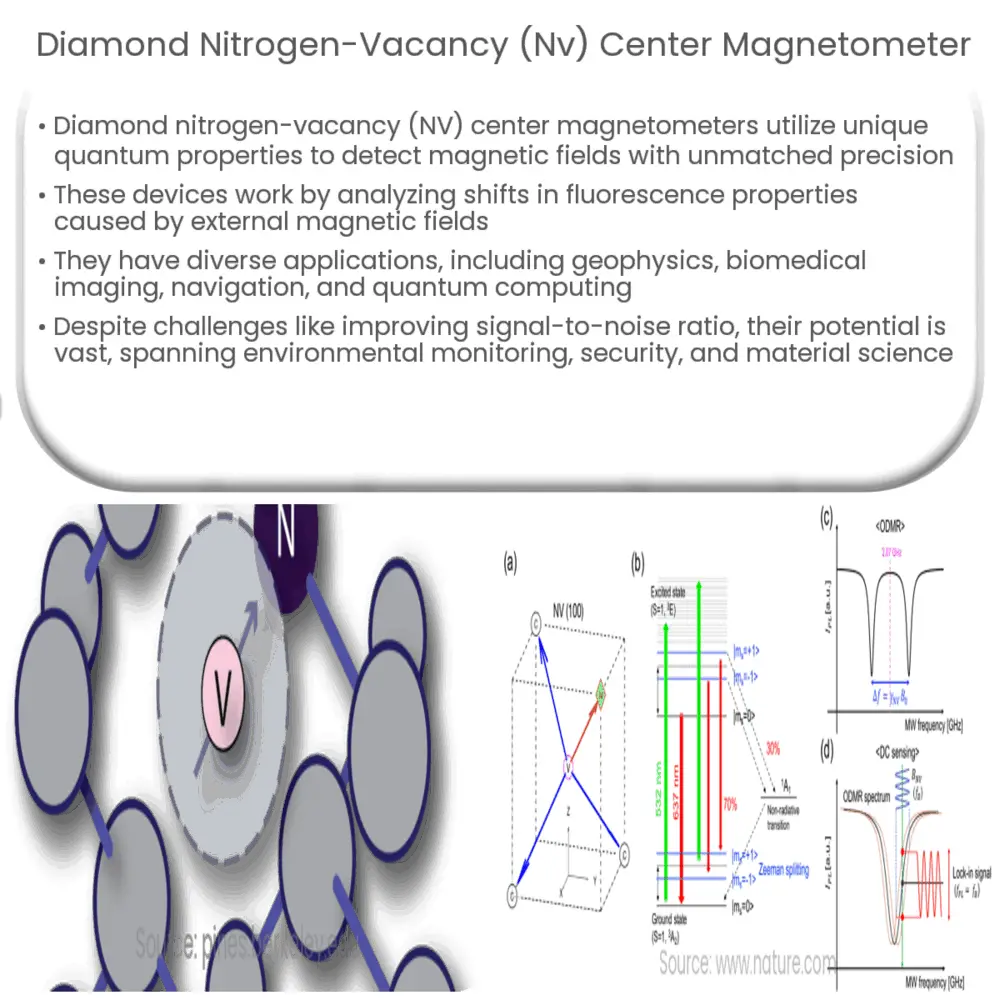Diamond NV center magnetometers use quantum properties of diamond defects to detect magnetic fields with exceptional sensitivity and precision.

Diamond Nitrogen-Vacancy (NV) Center Magnetometer: A Revolution in Sensing
Introduction
Diamond nitrogen-vacancy (NV) center magnetometers are emerging as a revolutionary tool in the field of magnetic sensing. These devices harness the unique quantum properties of diamond NV centers to detect and measure magnetic fields with unparalleled precision and sensitivity. In this article, we will delve into the fundamental principles behind diamond NV center magnetometers, explore their wide-ranging applications, and discuss the exciting prospects for future development.
What are Diamond NV Centers?
Diamonds are composed primarily of carbon atoms arranged in a crystalline lattice. Occasionally, a nitrogen atom replaces one of these carbon atoms, and an adjacent lattice site remains vacant. This unique defect within the diamond lattice, comprising a nitrogen atom and a vacancy, is known as a nitrogen-vacancy (NV) center. The NV center exhibits remarkable quantum properties, including stable electron spins that can be manipulated and measured at room temperature. These properties make diamond NV centers an ideal platform for sensing applications, particularly in the realm of magnetometry.
How do Diamond NV Center Magnetometers Work?
Diamond NV center magnetometers rely on the fact that the electron spins within NV centers are highly sensitive to external magnetic fields. When a magnetic field is applied, the energy levels of the NV center’s electron spins shift, leading to changes in the center’s fluorescence (light emission) properties. By optically pumping the NV centers and detecting the subsequent fluorescence, researchers can determine the magnetic field’s strength and direction.
The process begins with shining a green laser on the diamond, which excites the NV centers and aligns the electron spins. Then, a microwave pulse is applied to manipulate the spins. Finally, a second laser pulse is used to measure the resulting fluorescence. The intensity of the fluorescence signal depends on the electron spins’ alignment, which in turn depends on the external magnetic field. By analyzing the fluorescence signal, scientists can accurately determine the magnetic field’s properties.
Applications of Diamond NV Center Magnetometers
Diamond NV center magnetometers have a wide array of applications across various fields, including:
- Geophysics: They can be used to map the Earth’s magnetic field and detect anomalies, helping to locate natural resources and study geological formations.
- Biomedical imaging: Diamond NV center magnetometers have the potential to revolutionize magnetic resonance imaging (MRI) by providing a compact and highly sensitive alternative to conventional superconducting magnetometers.
- Navigation: These devices can be used as highly accurate magnetic compasses, which could be particularly valuable for underwater and underground navigation.
- Quantum computing: The unique quantum properties of NV centers have inspired research into their use as qubits, the building blocks of quantum computers.
Advantages of Diamond NV Center Magnetometers
Diamond NV center magnetometers offer several distinct advantages over traditional magnetic sensing technologies, such as:
- Sensitivity: These magnetometers can detect extremely weak magnetic fields, on the order of nanotesla or even picotesla, making them suitable for a wide range of applications.
- Spatial resolution: Diamond NV center magnetometers can achieve high spatial resolution, allowing for detailed mapping of magnetic fields.
- Room temperature operation: Unlike many other magnetic sensing technologies, these devices can function at room temperature, eliminating the need for bulky and expensive cryogenic systems.
- Robustness: Diamond NV center magnetometers are less susceptible to environmental factors such as temperature fluctuations and mechanical vibrations, making them more reliable in real-world conditions.
Challenges and Future Prospects
Despite the numerous advantages of diamond NV center magnetometers, there remain several challenges that must be addressed to fully exploit their potential. One key challenge is improving the magnetometers’ signal-to-noise ratio, which will enable even higher sensitivity and spatial resolution. Researchers are also exploring methods to enhance the scalability and miniaturization of these devices, paving the way for more portable and cost-effective solutions.
As the technology continues to advance, it is expected that diamond NV center magnetometers will have an even greater impact across various industries. In addition to the applications mentioned earlier, they could also play a significant role in fields such as:
- Environmental monitoring: These magnetometers can help detect and monitor pollution by tracking the presence of magnetic nanoparticles in air, water, and soil.
- Security: Diamond NV center magnetometers can be used to detect hidden electronic devices or metallic objects, making them valuable tools for surveillance, law enforcement, and border control.
- Material science: By providing detailed information about magnetic properties, these devices can assist in the characterization and development of novel materials and nanoscale structures.
Conclusion
Diamond nitrogen-vacancy center magnetometers are an exciting and rapidly developing field in magnetic sensing, offering significant advantages over traditional technologies. By leveraging the unique quantum properties of diamond NV centers, these devices have the potential to revolutionize a wide range of applications across various industries. As research continues to advance and overcome existing challenges, diamond NV center magnetometers are poised to make an even greater impact in the years to come.

